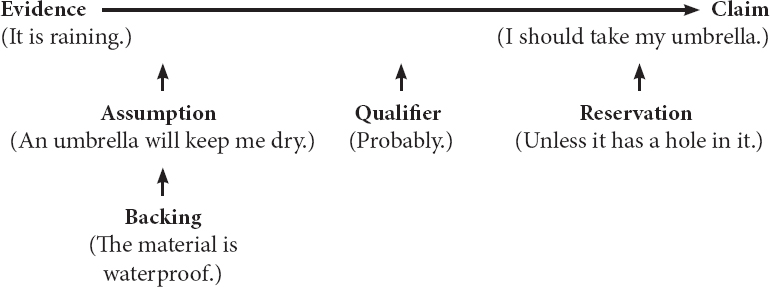Using the Toulmin Model
Printed Pages 126-127A useful way of both analyzing and structuring an argument is through the Toulmin model, an approach to argument created by British philosopher Stephen Toulmin in his book The Uses of Argument (1958). The Toulmin model is an effective tool in uncovering the assumptions that underlie arguments. Although at first this method—particularly its terminology—may seem complicated, it is actually very practical because it helps with analysis, structuring, qualifying a thesis, and understanding abstract arguments. Once mastered, it can be a very powerful tool.
The Toulmin model has six elements: claim, support (evidence), warrant (the assumption), backing, qualifier, and reservation. We have already discussed claims, which are arguable assertions. Toulmin defined a claim as “a conclusion whose merits we are seeking to establish.” You have also already learned about support or evidence. A warrant expresses the assumption necessarily shared by the speaker and the audience. Similar to the minor premise of a syllogism, the assumption links the claim to the evidence; in other words, if the speaker and audience do not share the same assumption regarding the claim, all the evidence in the world won’t be enough to sway them. Backing consists of further assurances or data without which the assumption lacks authority. The qualifier, when used (for example, usually, probably, maybe, in most cases, most likely), tempers the claim a bit, making it less absolute. The reservation explains the terms and conditions necessitated by the qualifier. In many cases, the argument will contain a rebuttal that gives voice to objections.
The following diagram illustrates the Toulmin model at work:

A Toulmin analysis will follow this form:
Because (evidence as support), therefore (claim), since (assumption), on account of (backing), unless (reservation).
If there is a qualifier (such as usually or maybe), it will precede the claim. In our examples, we will put “therefore” in parentheses to indicate that you would omit the word in your writing. Here is a simple illustration:
Because it is raining, (therefore) I should take my umbrella, since it will keep me dry.
You will immediately recognize the tacit assumption (that an umbrella will keep you dry) given explicit expression in the warrant. The backing would be “on account of the fact that the material is waterproof,” and the reservation might be “unless there is a hole in it.” In this case, the backing and reservation are so obvious that they don’t need to be stated. The diagram below illustrates this argument—a simple one indeed, but one that demonstrates the process:

Fully expressed, this Toulmin argument would read:
Because it is raining, (therefore) I should probably take my umbrella, since it will keep me dry on account of its waterproof material, unless, of course, there is a hole in it.